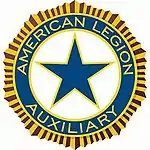American Legion Auxiliary
The American Legion Auxiliary (ALA) is a separate entity from the American Legion that shares the same values. Composed of spouses, mothers, daughters, granddaughters, and sisters of American war veterans. Founded in 1919, the ALA is dedicated to serving veterans, military, and their families.
 | |
| Established | 1919 |
|---|---|
| Type | Patriotic service organization |
| Purpose | Supporting The American Legion and honoring veterans, military, and their families. |
| Headquarters | 3450 Founders Road, Indianapolis, Indiana |
Region served | Worldwide |
Official language | English |
National President | Lisa Williamson |
National Vice President | Trish Ward |
| Publication | Auxiliary Magazine |
| Affiliations | The American Legion, Sons of The American Legion, American Legion Riders |
| Website | alaforveterans |
History
A group of 20 officers who served in the American Expeditionary Forces in World War I were asked to suggest ideas on how to improve troop morale. One officer, Lt. Col. Theodore Roosevelt Jr., proposed an organization of veterans, which we know today as The American Legion.
The original purpose of The Legion was “to preserve the memories and incidents of our association in the Great War,” helping those who had served in foreign wars to reintegrate into their hometowns while still remaining connected to those with whom they had served abroad.
The Legion served as a support group, a social club and an extended family for former servicemen. After two planning caucuses held by a committee of officers who had the confidence and respect of their military comrades, they designed a constitution to govern the group and set up headquarters in New York City to begin work on its programs of relief, employment and Americanism.
After the formation of The American Legion, a number of women's organizations wanted to become the official affiliation of The American Legion. The women who had served so faithfully during the trying days of the war wanted to continue to serve.
After careful consideration, the committee agreed that a new organization should be made up of the women most closely associated with the men of the Legion, and that these women would serve with the Legion, in peace as they had in war.
The committee decided to build a new organization from the ground up, so the Auxiliary could then carry forward the phases of Legion activities more suitably performed by women.
In less than one year, 1,342 local units of the Women’s Auxiliary to The American Legion had been organized in more than 45 states.
Eligibility
In 2019, the American Legion's National Convention voted to replace the word "wife" with "spouse" in the organization's constitution and bylaws section regarding eligibility to be a member of the American Legion Auxiliary; since then, male and female spouses of U.S. veterans have been eligible. Previously, only female spouses of U.S. veterans were.[1]
Programs
The American Legion Auxiliary's mission outreach committees are Americanism, Children and Youth, Community Service, Education, ALA Girls Nation, Junior Activities, Legislative, National Security, Poppy, and Veterans Affairs and Rehabilitation.
ALA members who work these programs help provide scholarships to military children; bring veterans to classrooms; give young women leaders an opportunity to learn how the federal government works; allow girls to develop leadership skills through volunteer experiences and other activities; advocate for veterans by supporting legislative priorities that benefit them; promote the poppy to raise awareness and respect for veterans who have died; and host stand downs and other events to improve the lives of veterans in the community.
Notable Members
References
- "Membership in the American Legion Auxiliary now open to male spouses of U.S. veterans and servicemembers".
- Binheim, Max; Elvin, Charles A (1928). Women of the West; a series of biographical sketches of living eminent women in the eleven western states of the United States of America. Retrieved 8 August 2017.
 This article incorporates text from this source, which is in the public domain.
This article incorporates text from this source, which is in the public domain.